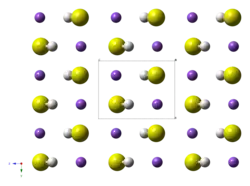Sodium hydrosulfide
Sodium hydrosulfide is the chemical compound with the formula NaSH. This compound is the product of the half-neutralization of hydrogen sulfide (H2S) with sodium hydroxide (NaOH). NaSH and sodium sulfide are used industrially, often for similar purposes. Solid NaSH is colorless. The solid has an odor of H2S owing to hydrolysis by atmospheric moisture. In contrast with sodium sulfide (Na2S), which is insoluble in organic solvents, NaSH, being a 1:1 electrolyte, is more soluble.
 | |
| Names | |
|---|---|
| IUPAC name
Sodium hydrosulfide | |
| Other names
Sodium bisulfide Sodium sulfhydrate Sodium hydrogen sulfide | |
| Identifiers | |
| |
3D model (JSmol) |
|
| ChEMBL | |
| ChemSpider | |
| ECHA InfoCard | 100.037.056 |
| EC Number |
|
PubChem CID |
|
| RTECS number |
|
| UNII | |
| UN number | 2922 2318 |
CompTox Dashboard (EPA) |
|
| |
| |
| Properties | |
| NaSH | |
| Molar mass | 56.063 g/mol |
| Appearance | off-white solid, deliquescent |
| Density | 1.79 g/cm3 |
| Melting point | 350.1 °C (662.2 °F; 623.2 K) (anhydrous) 55 °C (dihydrate) 22 °C (trihydrate) |
| 50 g/100 mL (22 °C) | |
| Solubility | Soluble in alcohol, ether |
| Structure | |
| rhombohedral | |
| Hazards | |
| Occupational safety and health (OHS/OSH): | |
Main hazards |
Flammable solid, stench, reacts with acids to release hydrogen sulfide |
| GHS labelling: | |
    | |
| Danger | |
| H226, H251, H290, H301, H314, H400 | |
| P210, P233, P234, P235+P410, P240, P241, P242, P243, P260, P264, P270, P273, P280, P301+P310, P301+P330+P331, P303+P361+P353, P304+P340, P305+P351+P338, P310, P321, P330, P363, P370+P378, P390, P391, P403+P235, P404, P405, P407, P413, P420, P501 | |
| NFPA 704 (fire diamond) | |
| Flash point | 90 °C (194 °F; 363 K) |
| Safety data sheet (SDS) | TDC MSDS |
| Related compounds | |
Other anions |
Sodium hydroxide Sodium amide |
Other cations |
Ammonium hydrosulfide |
Related compounds |
Sodium sulfide |
Except where otherwise noted, data are given for materials in their standard state (at 25 °C [77 °F], 100 kPa).
Infobox references | |
Structure and properties
Crystalline NaHS undergoes two phase transitions. At temperatures above 360 K, NaSH adopts the NaCl structure, which implies that the HS− behaves as a spherical anion owing to its rapid rotation, leading to equal occupancy of eight equivalent positions. Below 360 K, a rhombohedral structure forms, and the HS− sweeps out a discoidal shape. Below 114 K, the structure becomes monoclinic. The analogous rubidium and potassium compounds behave similarly.[1]
NaSH has a relatively low melting point of 350 °C. In addition to the aforementioned anhydrous forms, it can be obtained as two different hydrates, NaSH·2H2O and NaSH·3H2O. These three species are all colorless and behave similarly, but not identically. It can be used to precipitate other metal hydrosulfides, by treatment of aqueous solutions of their salts with sodium hydrosulfide. It is analogous to sodium hydroxide, and is a strong base.
Preparation
One laboratory synthesis entails treatment of sodium ethoxide (NaOEt) with hydrogen sulfide:[2]
- NaOCH2CH3 + H2S → NaSH + CH3CH2OH
An alternative method involves reaction of sodium with hydrogen sulfide.[3]
Applications
Thousands of tons of NaSH are produced annually. Its main uses are in cloth and paper manufacture as a makeup chemical for sulfur used in the kraft process, as a flotation agent in copper mining where it is used to activate oxide mineral species, and in the leather industry for the removal of hair from hides.[4]
References
- Haarmann, F.; Jacobs, H.; Roessler, E.; Senker, J. (2002). "Dynamics of anions and cations in hydrogensulfides of alkali metals (NaHS, KHS, RbHS): A proton nuclear magnetic resonance study". J. Chem. Phys. 117 (3): 1269–1276. Bibcode:2002JChPh.117.1269H. doi:10.1063/1.1483860.
- Eibeck, R. I. (1963). "Sodium Hydrogen Sulfide". Inorganic Syntheses. Inorganic Syntheses. Vol. 7. pp. 128–31. doi:10.1002/9780470132388.ch35. ISBN 9780470132388.
- Pavlik, Jeffrey W.; Noll, Bruce C.; Oliver, Allen G.; Schulz, Charles E.; Scheidt, W. Robert (2010). "Hydrosulfide (HS−) Coordination in Iron Porphyrinates". Inorganic Chemistry. 49 (3): 1017–1026. doi:10.1021/ic901853p. PMC 2811220. PMID 20038134.
- Butts, David; Bush, David R.; Updated By Staff (2013). "Sodium Sulfates and Sulfides". Kirk-Othmer Encyclopedia of Chemical Technology. doi:10.1002/0471238961.1915040902212020.a01.pub3. ISBN 978-0471238966.
